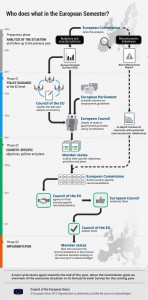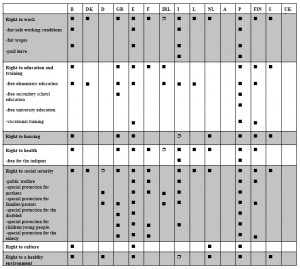2010-12-22: November & December 2010 … when the shit really started to hit the international economic fan ! … there has been an excess of hysterical nonsense in the Irish Media concerning growing European Union (EU) Economic Governance … and a perceived erosion of Irish National Sovereignty. How sad ?!?
Economic Environment … the intricate web of real and virtual human commercial activity – operating at micro and macro-economic levels – which facilitates, supports, but sometimes hampers or disrupts, human interaction in the Social Environment.
Social Environment … the complex network of real and virtual human interaction – at a communal or larger group level – which operates for reasons of tradition, culture, business, pleasure, information exchange, institutional organization, legal procedure, governance, human betterment, social progress and spiritual enlightenment, etc.
However, let me sketch out an altogether different and much more positive picture !
.
Thesis – My Argument
[During 2009, I first raised this issue in meetings of the IIEA (Institute of International & European Affairs) Economists’ Group, in Dublin.]
Towards the end of 2010 … we can now see that Inter-Governmental Economic Governance in the European Union has failed … miserably. This has not only destabilized the EuroZone … but the entire European Union, itself, as a political entity … and will continue to do so … until Economic Governance is brought much closer to, and fully within, the Community Method … which is a lengthy and complex process.
Back in 2009, however, when the Financial Markets were not in such a mad frenzy … it would have been natural to imagine that an interim stage in this process would most probably be to adopt an Open Method of Co-Ordination. This is no longer an option … being too little, too late, to calm the Markets.
Throughout this process of reform, the European Central Bank (ECB) and the National Central Banks can, and must, retain their independence … as legally mandated in European Union Primary Legislation, i.e. the Treaties.
.
Three Concerns I have had for some time …
– Economists don’t know the Community Method from the Rhythm Method, and they are ill-equipped to deal with matters of Mainstream European Union Institutional Reform ;
– The use of Economic Performance Indicators in the EU Stability & Growth Pact is simplistic and crude … and, therefore, very problematic ;
– Economic Performance Indicators must be improved … qualitatively … and be mainstreamed in considerations, and the implementation, of Sustainable Human & Social Development … as legally mandated in the EU Treaties.
.
Mr. Olli Rehn, European Commissioner for Economic & Monetary Affairs recently delivered a speech at the Institute of International & European Affairs, in Dublin …
Mr. Olli Rehn, European Commissioner
9 November 2010
Reinforcing EU Economic Governance: Relevance for Ireland
Click the Link Above to read and/or download PDF File (39kb)
However … instead of trying to desperately backfill the holes and gaps in the current, failed Inter-Governmental Method of Economic Governance in the European Union … Commissioner Rehn should be clearly identifying the proper target as the Community Method of Economic Governance … and plotting an appropriate course to reach that target … as soon as practicable !
.
This is a useful background document … and includes a lot of information about the EU Stability & Growth Pact …
European Commission & General Secretariat of the EU Council
June 2007
EU Economic & Monetary Union – Legal & Political Texts
Click the Link Above to read and/or download PDF File (2.66 Mb)
Since Ireland joined the European Economic Community (EEC) in 1973 … after 10 years of accession negotiations ! … an ‘informed’ view of European Integration has always been that the different Countries are pooling their national sovereignty, in an expanding range of specific areas, for the greater benefit of all their citizens. This has certainly been the experience of Ireland. And … let us also not forget that Irish Politicians and Senior Civil Servants have participated directly – at all stages – in the development of the EMU Legal & Political Texts listed. There is no such thing as a Domineering ‘Brussels’ Big Brother !
.
This is the most recent update of the EuroZone’s Economic Performance Indicators …
European Commission, Directorate-General for Economic & Financial Affairs (DG ECFIN)
2 December 2010
Key Economic Indicators for the Euro Area
Click the Link Above to read and/or download PDF File (360kb)
It is now widely acknowledged that Gross Domestic Product (GDP) is neither a reliable nor an adequate indicator of Sustainable Human & Social Development. But … that is another story … for another day !
.
Community & Inter-Governmental Methods of Governance
The Community Method is the expression used for the most common and effective operating and decision-making mode of institutions in the European Union. It proceeds from an integration logic, with due respect for the subsidiarity principle … and has the following salient features:
- European Commission monopoly of the Right of Initiative, with a strong monitoring role in implementation ;
- should consensus not be achieved, widespread use of Qualified Majority Voting in the Council of the European Union ;
- an active, participatory role for the European Parliament ;
- uniform interpretation of EU Law by the Court of Justice.
In contrast to the … Inter-Governmental Method … which proceeds from an inter-governmental logic of co-operation between EU Member States … to a large extent outside the institutional framework of the European Union … and has the following salient features:
- the European Commission’s Right of Initiative is shared with the Member States or confined to specific areas of activity … with little, if any, monitoring role for the Commission in implementation ;
- the Council of the European Union generally acts unanimously … and unilaterally ;
- the European Parliament has merely a consultative role ;
- the Court of Justice plays only a minor role.
.
Open Method of Co-Ordination
The Open Method of Co-Ordination (OMC) developed as an instrument of the 2000 Lisbon Strategy, and provided a new framework for co-operation between the EU Member States, whose national policies could thus be directed towards certain common objectives.
Under this method of governance, the Member States are evaluated by one another (peer pressure), with the European Commission’s role being limited to ‘lite’ surveillance. The European Parliament and the Court of Justice play virtually no part in the OMC process.
The Open Method of Co-Ordination takes place in policy areas which fall within the competence of the Member States … such as employment, social protection, social inclusion, education, youth and training.
It is based principally on:
- jointly identifying and defining objectives to be achieved (adopted by the Council of the European Union) ;
- jointly established measuring instruments (statistics, indicators, guidelines) ;
- benchmarking, i.e. comparison of the Member States’ performance and exchange of best practices (oversight by the European Commission).
Depending on the areas concerned, the OMC involves so-called ‘Soft Law’ Measures which are binding on the Member States to varying degrees but which never take the form of ‘Hard Law’ Directives, Regulations or Decisions. Thus, in the context of the Lisbon Strategy, the OMC required the Member States to draw up national reform plans and to submit them to the European Commission.
.

Ireland’s National Sovereignty in 2010/2011 ?
On a beautiful sunny day, this past autumn … I again visited Arbour Hill Cemetery in Dublin … the last resting place for many Executed Leaders of the 1916 Revolution … an event which finally initiated an irrevocable process of terminating a prolonged period of barbaric external imperial domination and cultural cleansing of the indigenous population …

.
On the wall behind the graves … the 1916 Proclamation of Independence is inscribed in the Irish Language, and also in English …
Poblacht na hEíreann
THE PROVISIONAL GOVERNMENT OF THE IRISH REPUBLIC
TO THE PEOPLE OF IRELAND
IRISHMEN AND IRISHWOMEN: In the name of God and of the dead generations from which she receives her old tradition of nationhood, Ireland, through us, summons her children to her flag and strikes for her freedom.
Having organized and trained her manhood through her secret revolutionary organization, the Irish Republican Brotherhood, and through her open military organizations, the Irish Volunteers and the Irish Citizen Army, having patiently perfected her discipline, having resolutely waited for the right moment to reveal itself, she now seizes that moment, and, supported by her exiled children in America and by gallant allies in Europe, but relying in the first on her own strength, she strikes in full confidence of victory.
We declare the right of the people of Ireland to the ownership of Ireland, and to the unfettered control of Irish destinies, to be sovereign and indefeasible. The long usurpation of that right by a foreign people and government has not extinguished the right, nor can it ever be extinguished except by the destruction of the Irish people. In every generation the Irish people have asserted their right to national freedom and sovereignty: six times during the past three hundred years they have asserted it in arms. Standing on that fundamental right and again asserting it in arms in the face of the world, we hereby proclaim the Irish Republic as a Sovereign Independent State, and we pledge our lives and the lives of our comrades-in-arms to the cause of its freedom, of its welfare, and of its exaltation among the nations.
The Irish Republic is entitled to, and hereby claims, the allegiance of every Irishman and Irishwoman. The Republic guarantees religious and civil liberty, equal rights and equal opportunities to all its citizens, and declares its resolve to pursue the happiness and prosperity of the whole nation and of all its parts, cherishing all the children of the nation equally, and oblivious of the differences carefully fostered by an alien government, which have divided a minority from the majority in the past.
Until our arms have brought the opportune moment for the establishment of a permanent National Government, representative of the whole people of Ireland and elected by the suffrages of all her men and women, the Provisional Government, hereby constituted, will administer the civil and military affairs of the Republic in trust for the people.
We place the cause of the Irish Republic under the protection of the Most High God, Whose blessing we invoke upon our arms, and we pray that no one who serves that cause will dishonour it by cowardice, inhumanity, or rapine. In this supreme hour the Irish nation must, by its valour and discipline and by the readiness of its children to sacrifice themselves for the common good, prove itself worthy of the august destiny to which it is called.
Signed on Behalf of the Provisional Government,
THOMAS J. CLARKE,
SEAN Mac DIARMADA, THOMAS Mac DONAGH,
P. H. PEARSE, EAMONN CEANNT,
JAMES CONNOLLY, JOSEPH PLUNKETT.
.
As We Approach the 100th Anniversary of the 1916 Revolution … Ireland has failed to implement and foster the social values so eloquently elaborated in the 1916 Proclamation of Independence … widespread, deeply ingrained corruption infects our economic environment … and the institutions of national governance are dysfunctional and no longer ‘fit for purpose’ … while individuals within those institutions rise in rank according to their own natural level of incompetence.
Politically … Ireland has not yet properly matured as an Independent State.
.
Ireland’s Relationship with the European Union … I am more than a little curious as to why Ireland is not associated with Declaration No.52, which is annexed to the Treaty of Lisbon …
52. Declaration by the Kingdom of Belgium, the Republic of Bulgaria, the Federal Republic of Germany, the Hellenic Republic, the Kingdom of Spain, the Italian Republic, the Republic of Cyprus, the Republic of Lithuania, the Grand-Duchy of Luxembourg, the Republic of Hungary, the Republic of Malta, the Republic of Austria, the Portuguese Republic, Romania, the Republic of Slovenia and the Slovak Republic on the symbols of the European Union
Belgium, Bulgaria, Germany, Greece, Spain, Italy, Cyprus, Lithuania, Luxemburg, Hungary, Malta, Austria, Portugal, Romania, Slovenia and the Slovak Republic declare that the flag with a circle of twelve golden stars on a blue background, the anthem based on the ‘Ode to Joy’ from the Ninth Symphony by Ludwig van Beethoven, the motto ‘United in diversity’, the euro as the currency of the European Union and Europe Day on 9 May will for them continue as symbols to express the sense of community of the people in the European Union and their allegiance to it.
Yes … we have a lot to discuss before 2016 !
.
.
Update: 2013-06-03 …
On Friday, 31 May 2013, at the Institute of International & European Affairs (IIEA) in Dublin … I attended the third seminar in a series organized to mark Ireland’s Presidency of the Council of the European Union (January to June 2013) … the seventh such Presidency … and 40 years since Ireland officially joined the European Economic Community (EEC), on 1 January 1973 … after a long, long, long accession process …
‘Economic Sovereignty in an Age of Globalization and EU Integration – Economic, Legal and Political Perspectives’
[ For full information about this IIEA Economic Seminar: www.iiea.com ]
Because the seminar was not only very interesting, but is directly relevant in the context of this post … and the remarks of Mr. Peter Sutherland, Chairman of Goldman Sachs International and the London School of Economics, and former Irish Attorney General, former European Commissioner and former Director-General of the World Trade Organization, caused quite a stir in the printed media on the following day … here is Paper 2 from Seminar Session I … which went to the heart of discussions on the day …
Prof. John W O’Hagan, Dept. of Economics, Trinity College Dublin, Ireland
Shared Economic Sovereignty: Beneficial or Not, and Who Decides ?
Click the Link Above to read and/or download PDF File (635 Kb)
.
.
Update: 2014-07-04 …
Economists exist and operate in a special bubble … in their own little isolated world of quasi-science and fantasy, where everything in ‘our’ society is seen merely as an input, or fuel, for economic development. And when they talk about Sustainable Economic Growth … believe me, their notion of ‘sustainable’ is altogether different from our understanding of that word !
European Union Economic Governance
It should come as no surprise to learn, therefore, that economists are blissfully unaware that the EuroZone’s current directionless (and dysfunctional) economic governance is causing enormous instability and harm to the whole political entity that is the European Union …

.
This issue is too important for all of us … to be left to economists and national politicians, alone, to muddle through !
.
.
END








